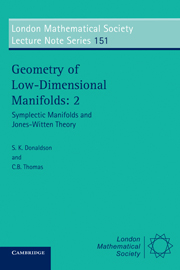Book contents
- Frontmatter
- Contents
- Contributors
- Names of Participants
- Introduction
- Acknowledgements
- PART 1 SYMPLECTIC GEOMETRY
- Introduction
- Rational and ruled symplectic 4-manifolds
- Symplectic capacities
- The nonlinear Maslov index
- Filling by holomorphic discs and its applications
- PART 2 JONES/WITTEN THEORY
- PART 3 THREE-DIMENSIONAL MANIFOLDS
Rational and ruled symplectic 4-manifolds
Published online by Cambridge University Press: 01 June 2011
- Frontmatter
- Contents
- Contributors
- Names of Participants
- Introduction
- Acknowledgements
- PART 1 SYMPLECTIC GEOMETRY
- Introduction
- Rational and ruled symplectic 4-manifolds
- Symplectic capacities
- The nonlinear Maslov index
- Filling by holomorphic discs and its applications
- PART 2 JONES/WITTEN THEORY
- PART 3 THREE-DIMENSIONAL MANIFOLDS
Summary
INTRODUCTION
This note describes the structure of compact symplectic 4-manifolds (V, ω) which contain a symplectically embedded copy C of S2 with non-negative self-intersection number. (Such curves C are called “rational curves” by Gromov: see [G].) It turns out that there is a concept of minimality for symplectic 4-manifolds which mimics that for complex surfaces. Further, a minimal manifold (V, ω) which contains a rational curve C is either symplectomorphic to ℂP2 with its usual Kähler structure τ, or is the total space of a “symplectic ruled surface” i.e. an S2-bundle over a Riemann surface M, with a symplectic form which is non-degenerate on the fibers. It follows that if a (possibly non-minimal) (V,ω) contains a rational curve C with C·C > 0, then (V, ω) may be blown down either to S2 × S2 with a product form or to (ℂP2, τ), and hence is birationally equivalent to ℂP2 in Guillemin and Steinberg's sense: see [GS]. (In analogy with the complex case, we will call such manifolds rational.) Moreover, if V contains a rational curve C with C·C = 0, then V may be blown down to a symplectic ruled surface. Thus, symplectic 4-manifolds which contain rational curves of non-negative self-intersection behave very much like rational or ruled complex surfaces.
It is natural to ask about the uniqueness of the symplectic structure on the manifolds under consideration: more precisely, if ω0 and ω1 are cohomologous symplectic forms on V which both admit rational curves of non-negative self-intersection, are they symplectomorphic?
- Type
- Chapter
- Information
- Geometry of Low-Dimensional ManifoldsSymplectic Manifolds and Jones-Witten Theory, pp. 7 - 14Publisher: Cambridge University PressPrint publication year: 1991
- 3
- Cited by

